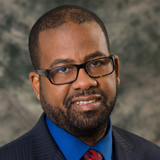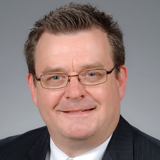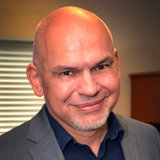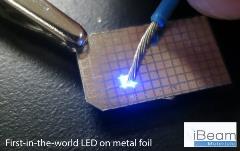Leonard Brillson
Editor, INTERSECTIONS
Member, Government Affairs Committee
Welcome to our Summer 2016 Newsletter!
Welcome to our Summer 2016 Newsletter! With Congress wrapping up their legislative activities and heading home to campaign, the Government Affairs Committee (GAC) has much to report on activities that impact support for materials science and technology. GAC aims to understand the dynamically changing legislative policy environment and its impact on materials research.
The MRS Director of Government Affairs, Damon Dozier, describes the effects of Senate and House Appropriations committee bills for key federal science and technology agencies and MRS’s involvement in recommendations to the incoming Administration for filling key slots in federal agencies.
GAC Chair, Kevin Whittlesey, discusses how the Committee seeks to prioritize our advocacy activities and how best to serve our international members.
Brent Carey, Grassroots Subcommittee Chair, discusses key science policy issues, and encourages readers to write to Congress using our Materials Voice letter-writing platform.
In the MRS Congressional Science and Engineering Fellowship Corner, Gavi Begtrup introduces the new MRS Congressional Fellows, highlights where several current and past Fellows are now, and announces the opening of the application period for the 2017-2018 Fellowships.
Congressional Visits Day Subcommittee Chair, Linda Olafsen, describes preparations for MRS Officers and board members to visit Capitol Hill lawmakers and Federal funding agencies this fall. They will continue to emphasize the critical importance and impact of federally funded research as well as the reauthorization of America COMPETES.
Chair of the Government Agency Subcommittee, David Norton, previews the 2016 MRS Fall Meeting, which will again provide opportunities to connect researchers with funding agency representative as well as to provide insight into the roles of each agency.
Finally, Vladimir Matias’ INTERSECTIONS article on value-added materials science features yet another success story, highlighting how investments in materials science pay off in ways that the general public, and especially our elected officials, can relate.
MRS is working hard to make sure that the materials research community is being heard and that it has input in developing effective government policy for support of materials science. Here is the latest news.
Government Affairs Committee Chair News—Advocacy Priorities & International Members
 Kevin Whittlesey
Kevin Whittlesey
Chair, Government Affairs Committee
As we head into election season, the activity level in Washington is expected to decline as Members of Congress and their respective parties focus their attention on winning seats. Congress still has to pass something in the way of an appropriations bill to keep the government open for the 2017 fiscal year (FY17) which starts on October 1; but it is more likely than not that we will have a continuing resolution until December 9. While this means there may not be a lot of opportunity for direct advocacy efforts, this is an excellent time for Government Affairs Committee (GAC) to take stock of our agenda and how best to apply our resources in the near- and mid-term.
A key question that we need to ask is how we will determine our advocacy priorities in the future. GAC has received feedback that sources of federal research funding for some MRS members are not typically included in our advocacy agenda. GAC needs to ensure that we are best serving the needs of MRS members while considering our resource limitations. GAC is currently formulating plans to obtain input from the MRS membership to ensure that we have as much data from members as possible to inform our advocacy agenda. While the agencies for which we advocate may or may not change as a result, it is important that we ensure that our efforts are aligned with the current state of the materials research field.
Another important question GAC needs to consider is how to best serve the international materials community. This is a particular challenge. MRS draws roughly half its members from outside of the US, and GAC needs to serve all MRS members. Advocacy, however, is inherently a regional activity. GAC lacks the bandwidth and resources to be able to effectively engage in direct advocacy efforts in all of the countries represented in MRS membership. How GAC can efficiently and effectively serve international members is an active and ongoing area of discussion and an important one in formulating our strategy moving forward.
Recently, some aspects of the Government Affairs Committee, particularly the subcommittee structure, were redesigned in order to address this issue of better serving the international community. The new structure also allows us flexibility to be responsive to new needs that arise.
As a result, there are new and exciting opportunities for GAC volunteers to help address the needs and expectations of the materials research community. GAC looks forward to engaging both our existing volunteers and new volunteers who are interested in helping to address these, and other topics, on behalf of the MRS membership.
What's Happening in Washington
 Damon Dozier
Damon Dozier
MRS Director of Government Affairs
At the beginning of the new session, Congress was very active in its efforts to pass all of the appropriations bills on time, as well as take action on renewing authorizations for key agency programs of particular concern for MRS membership.
The House Appropriations Committee finalized the 2017 Commerce, Justice, Science (CJS) Appropriations bill, and it was marked up by the Commerce, Justice and Science subcommittee shortly thereafter. The bill funds the Departments of Commerce and Justice, the National Aeronautics and Space Administration (NASA), the National Science Foundation (NSF), and other related agencies. In terms of NSF, the report includes positive language in terms of peer review. The report language notes that "...the Committee has long been supportive of NSF’s peer review process to identify and recommend funding for scientifically meritorious research. NSF’s ability to fund cutting-edge research helps keep the United States at the forefront of research across all scientific disciplines, which in turn builds the technological capabilities that underpin economic growth and prosperity." As you might remember, NSF's peer review process had been under scrutiny by the House Science Committee for some time, with Chairman Smith attempting to add language that would require the agency to consider grants that fit a "national interest" standard, stating several criteria that range from “increased economic competitiveness” to “promotion of the progress of science.” In addition, the report language also directs NSF to continue its efforts to ensure that award abstracts clearly explain in plain English the intent of the project and how the project meets both the intellectual merit and the broader impact review criteria. Improving the peer review process and project abstracts is critical to protecting NSF’s stellar scientific integrity. The abstracts serve as a public justification for NSF funding decisions by articulating how the project serves the national interest, consistent with the Foundation’s mission as established in the National Science Foundation Act of 1950 (42 U.S.C. 1861 et seq). The Committee believes that abstracts should explain how a project:
- increases economic competitiveness in the US;
- advances the health and welfare of the American public;
- develops an American STEM workforce, including computer science and information technology sectors, that are globally competitive;
- increases public scientific literacy and public engagement with science and technology in the US;
- increases partnerships between academia and industry in the US;
- supports the national defense of the US;
- or promotes the progress of science for the US.
The Senate also passed its energy bill, which, among other things, would expedite the federal approval process for liquefied natural gas exports, streamline the approval process for electric transmission lines, increase cybersecurity protections for the electricity grid, and expedite the licensing process for hydropower projects. The House alternative energy bill also included its version of COMPETES, which has many problematic provisions we've discussed before, including—
Energy Efficiency and Renewable Energy (EERE) R&D
The 2017 fiscal year (FY17) authorization level is 42%, or $876 million, below the FY16 appropriated level, and 59% below the President’s FY17 request level. It is also 35% below the current level in the FY17 House Energy and Water Development Appropriations bill. In addition, the amendment attempts to authorize a 42% cut to the already enacted funding level for FY16.
ARPA-E
The FY17 authorization level is 52%, or $151 million, below the FY16 appropriated level, and 60% below the President’s FY17 request level. It is also 54% below the current level in the FY17 House Energy and Water Development Appropriations bill. In addition, the amendment attempts to authorize a 52% cut to the already enacted funding level for FY16.
Office of Science’s Biological and Environmental Research Program (BER)
The FY17 authorization level is 9.7%, or $59 million, below the FY16 appropriated level, and 16.9% below the President’s FY17 request level. It is also 7.6% below the current level in the FY17 House Energy and Water Development Appropriations bill. In addition, the amendment attempts to authorize a 9.7% cut to the already enacted funding level for FY16.
The Senate version of COMPETES, however, is a better alternative, with a 4% increase in authorization levels for NSF, as well as improved STEM initiatives and protecting the integrity of the peer review process.
The House and Senate Appropriations Committees have also released their proposals for NIST funding. The Senate would increase NIST’s topline budget by a slight 1.0% and the House would impose a deep 10.3% cut. Much of the House’s proposed cuts would fall on the President’s priorities: The National Network for Manufacturing Innovation and the construction of research facilities, including the ongoing renovation of the radiation physics laboratories (Building 245) on NIST’s Gaithersburg campus.
MRS has also been working with the National Nanotechnology Coordination Office and collaborating on several new activities. Government Affairs Committee (GAC) Chair Kevin Whittlesey, MRS Executive Director, Todd Osman, and MRS headquarters staff members met with NNCO officials earlier this year and discussed ways in which MRS and NNCO could collaborate, including potential participation in future policy forums, outreach to students and teachers with a need for resources about nano and holding focus group meets at MRS Meetings regarding nano and commercialization.
MRS is investigating the possibility of convening a new Blue Ribbon Panel to make recommendations to the incoming Administration about filling key slots in federal agencies and other posts of importance. Al Hurd will be leading the effort, and plans are in place to move forward in the coming weeks.
Grassroots Subcommittee Chair News—Draft Letters to Impact Congress
 Brent Carey
Brent Carey
Chair, Grassroots, Congressional Fellow Subcommittee
While political discourse has been largely focused on the impending presidential election, there are some important things going on to round out the 114th Congress. The Grassroots Subcommittee has identified a few topics that could benefit from some additional support to either complete during this session or position for activity in the next Congress.
Senate leadership is positioning to push another (another!) continuing resolution to maintain federal funding without going through the full appropriations process. This type of budgetary chicanery is particularly challenging for S&T and innovation due to challenges that stem from the long project timelines in research, as well as difficulties in staffing a specialized technical workforce.
There are two particular pieces of active legislation that the Grassroots Subcommittee believes can be influenced by our community. There are several active bills related to the COMPETES act, which aims to increase basic research investment in the physical sciences, as well as strengthen educational opportunities in STEM fields and develop a robust innovation infrastructure. One in particular is being accelerated in an attempt to initiate action prior to the end of the legislative session. Similarly, a comprehensive energy bill (which would be the first passed in 9 years) has a fighting chance to hit the President’s desk for signing into law before the end of the year.
These topics affect much of the MRS membership, and the Grassroots Subcommittee will be assessing these issues critically to draft letters highlighting the importance of these issues. Using Materials Voice—our letter-writing platform—MRS members will be able to email these pre-drafted letters to their representatives and ensure legislators are aware of the important issues. If you’re planning to attend the 2016 MRS Fall Meeting, be sure to stop by the Materials Voice kiosk and send the letters to your representatives to give some support!
MRS Congressional Science & Engineering Fellowship Corner
 Gavi Begtrup
Gavi Begtrup
Chair, Congressional Fellow Subcommittee
The 2016-17 Congressional Fellows have arrived in Washington!
On August 30, our new Congressional Science and Engineering Fellows, Felicia Lucci [MRS/ Optical Society of America (OSA)] and Aaron Dunn [MRS/ The Minerals, Metals and Materials Society (TMS)], joined a dozen former MRS Fellows, members of the Government Affairs Committee, and MRS Director of Government Affairs, Damon Dozier, for our annual kickoff breakfast at Café DuPont in DuPont Circle. This was a chance for Felicia and Aaron to be introduced to our wonderful Fellows’ alumni network as well as to hear anecdotes from years on the Hill, ranging from Congressional antics to stories of how national events and disasters changed the scope of fellowship years.
Felicia and Aaron are now wrapping up a two-week-long science policy orientation program organized by the American Association for the Advancement of Science (AAAS) to provide an introduction to the policy and political landscape before they begin interviewing with Congressional offices to find their placement for the duration of their fellowship year. Look for an update in a future issue of INTERSECTIONS for information on their placement offices and policy issue areas.
The new Fellows are the 29th and 30th that MRS has sponsored or co-sponsored, and represent the 22nd year of the fellowship. The growing fellowship alumni network boasts leaders in positions across the spectrum including academia, industry, startups, government and policy, as well as a number who have remained on the Hill in various capacities.
Already looking towards next fall, the application process for the 2017-2018 fellowship term is now officially open. Information on how to apply for the MRS/OSA and MRS/TMS Congressional Science and Engineering Fellowships can be found at www.mrs.org/congressional-fellows.
Peter Winter, the 2015-16 MRS/OSA Fellow in the office of Senator Chris Coons, is now an AAAS S&T Executive Fellow at the Department of Energy – Advanced Manufacturing Office. Jeremy Ward, the 2015-16 MRS/TMS Fellow in the Office of Senator Richard Durbin, is now a Research Scientist for UES, Inc. working at the Air Force Research Laboratory at Wright-Patterson Air Force Base.
Fall Congressional Visits Day, Broader Impact
 Linda J. Olafsen
Linda J. Olafsen
Chair, Congressional Visits Day Subcommittee
The Congressional Visits Day (CVD) Subcommittee is preparing for a fall visit to Capitol Hill on October 25 and 26. As with previous fall CVD events, this visit is primarily oriented around the MRS Executive Committee and Board of Directors, providing officers and board members with the opportunity to learn about the impact of the Government Affairs Committee (GAC) and CVD activities.
In addition to MRS leadership, several invitations have been extended to other MRS members specifically to enable constituent visits to offices of key members of the science and appropriation committees. Visits are planned to members in Colorado, Indiana, Michigan, New Mexico, New York, Pennsylvania, and Texas. Based upon experience and feedback from previous visits, some materials are being updated to provide the most relevant and useful leave behinds for Congressional members and their staff. Important topics for discussion will include the critical importance and impact of federally funded research as well as the reauthorization of America COMPETES.
The CVD event on October 26 will be followed by an Agency Visits Day on October 27. Participants will include MRS President-Elect, Susan Troiler-McKinstry, MRS Executive Director, Todd Osman, and MRS Director of Government Affairs, Damon Dozier. Agency visits provide a venue for MRS leadership to advocate with management at federal funding agencies, including the National Science Foundation, National Institutes of Health, and Department of Energy.
Preview of the 2016 MRS Fall Meeting—Connecting the Federal Funding Agencies to the Materials Research Community
 David P. Norton
David P. Norton
Chair, Government Agency Subcommittee
At the upcoming 2016 MRS Fall Meeting in Boston, the Government Affairs Committee (GAC) will present the Research Funding Opportunities session (formerly known as the Government Agency Presentations). During the session, representatives from federal agencies that support materials research will describe programs and funding opportunities. These presentations should be of significant interest to the materials research community attending the Meeting, whether they work in government laboratories, academia, or industry. We have invited representatives from the National Science Foundation, the Department of Energy, the Department of Defense, and other federal agencies to participate.
This year, the session will follow a different format and will occur on the evening of Tuesday, November 29. The six invited agency representatives will make brief presentations followed by opportunities to interact with attendees in smaller groups in a roundtable discussion format. The objective is to provide agency representatives and researchers a better opportunity for meaningful discussion. Details on how Meeting attendees can participate in these small group discussions will be provided prior the Meeting.
The Research Funding Opportunities session not only connects researchers with funding agency representatives, it also serves as an opportunity for members of the materials research community to better understand the role of each agency in supporting basic and applied research, and to see how they might advocate for public and private investments into research. Research efforts within universities, industry, and R&D laboratories stand to benefit from national investments in the research enterprise both within and outside the US, whether it is supporting high-risk, high reward research, long-term fundamental studies, or early career scientist who represent the next generation of discoverers. Federal governments are also increasingly active in facilitating the translation of research into innovative commercial applications. Whether it is recent breakthroughs in polymers, insights into mechanical, electronic, or photonic behavior, or applications centered around sensors, these agencies are vitally important in supporting our community.
A Value-Added Materials Research Story
Light Emitting Materials on Large Flexible Foils
 Vladimir Matias
Vladimir Matias
Founder and President, iBeam Material
I have always believed that materials discoveries offer new possibilities in radically altering technological paths forward. iBeam Materials was started as a materials technology company with that goal in mind. The company is a spin out from Los Alamos National Laboratory.
I worked at Los Alamos as a team and project leader for 11 years on superconductor wire technology. As part of this work, we developed a process for crystal alignment in thin films using an ion beam deposition process, known as IBAD texturing. The original discovery of this remarkable phenomenon was made by Robert Hammond and his team at Stanford University in the mid-1990s. I was always very intrigued by this process and by the science behind it. However, although the science was fascinating but difficult to examine, I was even more eager to put the process to use and make it ever more practical. The process allowed one to make single-crystal like films on arbitrary substrates, not just single-crystal wafers. Superconductor application of IBAD was already developed quite extensively by people at Los Alamos and elsewhere, but I wanted to explore other possibilities, esp. in semiconductor materials such as GaN. Hence, I left the Lab when our Department of Energy (DOE) Superconductivity program funding ended, and with the help of Los Alamos, I started iBeam Materials in Santa Fe.
 The company was bootstrapped based on a business I was able to have in the superconductivity space, but I quickly turned to government R&D funding for new applications of IBAD. We formed a team to work on GaN applications with Dr. Daniel Koleske, an expert on GaN growth at Sandia National Laboratories. We were fortunate to obtain ARPA-E funding to work on this project. Within just a year of working on the project, we demonstrated the first-in-the-world world InGaN LED devices completely fabricated on polycrystalline flexible metal foil. In the past, I had dreamed this would be possible, but now it was. Most people had doubted it, and it was very gratifying to have this vision turn into reality. Now my dreams got bigger in that I believe we can improve materials further and make these devices comparable to GaN devices on single-crystal sapphire. Only time will tell.
The company was bootstrapped based on a business I was able to have in the superconductivity space, but I quickly turned to government R&D funding for new applications of IBAD. We formed a team to work on GaN applications with Dr. Daniel Koleske, an expert on GaN growth at Sandia National Laboratories. We were fortunate to obtain ARPA-E funding to work on this project. Within just a year of working on the project, we demonstrated the first-in-the-world world InGaN LED devices completely fabricated on polycrystalline flexible metal foil. In the past, I had dreamed this would be possible, but now it was. Most people had doubted it, and it was very gratifying to have this vision turn into reality. Now my dreams got bigger in that I believe we can improve materials further and make these devices comparable to GaN devices on single-crystal sapphire. Only time will tell.
iBeam’s technology is still at an early stage, and the company has not raised any private funds yet. However, we have big ambitions and seek to disrupt the lighting, display and wearable electronics industries by creating new game-changing product categories. Our IBAD technology allows one to replace the current rigid and small-wafer batch manufacturing of GaN-based devices with extremely scalable and inherently low-cost roll-to-roll processing. Printing of LEDs can then be used to replace pick and place LED technology and enable integration of various electronic devices. In the end, new technological possibilities will also create a new generation of products, such as paper-thin super-bright flexible displays.
The Wearable Electronics market is $12B today and growing rapidly. The overall Lighting and Display markets are currently $100B each. We see our technology as enabling very-low-cost and low-power lighting that will change the way the world uses light.
Feedback
We welcome your feedback and invite you to submit topics for consideration in future issues of this newsletter. If you have or know of stories that illustrate how an investment in materials research paid off in real dollar terms, please send your suggestions to INTERSECTIONS Editor, Len Brillson, at [email protected]. Please send your comments to [email protected].
Sign up for MRS newsletters and alerts by visiting My MRS. There you can login or create an account, and select INTERSECTIONS under Public Policy to receive this quarterly newsletter via email.
Not a current MRS member? It’s never too late to join or renew.